
Glock 18 - MGC
I kind of swore to myself that I'd never have another Glock 18, but I was always intrigued by the look of the early ones, with the long barrel with the vents ahead of the slide. I even considered creating one with a KSC Glock 18C and a Glock 34 barrel, but gave up on the idea.
MGC made one many moons ago, but, like most MGC classic GBBs they tend to be rare and expensive, so when one came up on the forum at a very affordable price (admittedly in less than pristine condition) I was tempted and had another Glock in my hands.
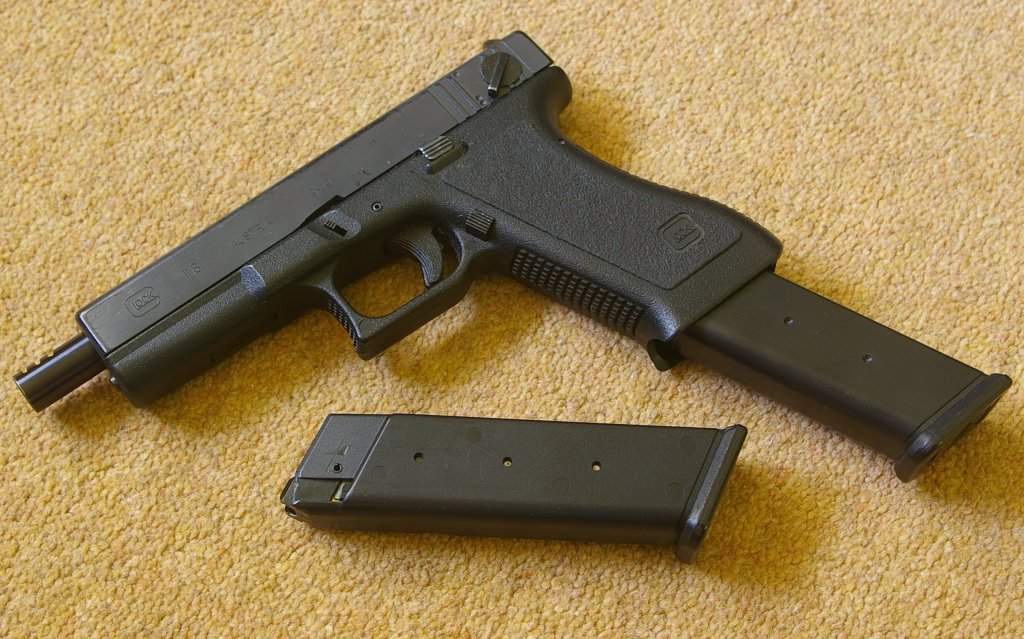
MGC (with the legendary Tanio Kobayashi in charge of design) was the trailblazer of GBBs, so I was interested to see how this old design (originally released in the early 1990s) would stack up against the latest Glocks from KSC.
In the Box
There was no box with my Glock 18, but I tracked down the images below of a mint MGC Glock 18 (courtesy of ViciousV10 on Arnie's).

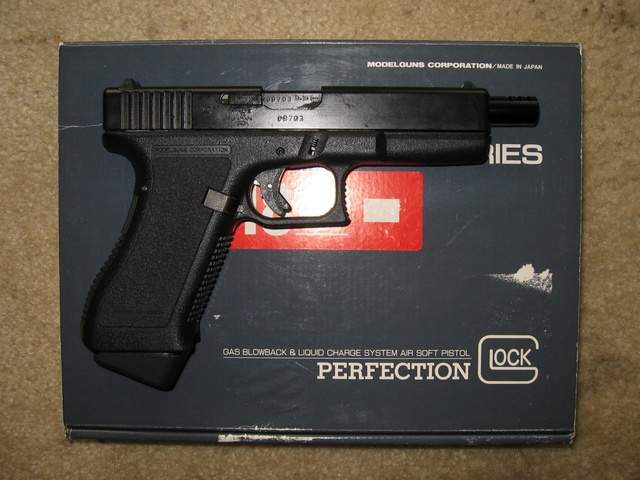
As you can see, there's a rod, tube and hopper speed loader, a bag of green(!) BBs and the manual.
The gun itself sits in a polystyrene bed,within the cardboard outer, which holds the gun securely.
First Impressions
Compared to a KSC Glock 18C the first impression is of how good the MGC looks.
Mine has a rather care-worn slide, with quite a few scratches, but the frame lacks the cheap plastic shiny finish that the KSC gun has.

Most notable difference, as the gun lies on the table or in the box (if you have one), is, of course, the barrel. The MGC replicates the earliest Glock 18, with the solid-topped 17 style slide and a barrel which extends from the front of it, with compensator vents cut in it.
Later guns, nomenclatured Glock 18Cs, feature a 17 length barrel (almost flush with the slide front) with a cutout slide and vents in the barrel which vent through that. KSC's (and TM's EBB and AEP) gun replicates this later model.
As well as the good looking frame material, the MGC features excellent Glock logos on the slide and grip and soft panels on either side of the grip, which give the gun a quality feel.
The MGC does, however, feel much lighter than a KSC Glock 18C, not helped much by the lightweight slide or the plastic shelled magazine, although it is interesting to note that, looking back, a KWA Glock 18C I weighed was a fair bit lighter without its magazine.
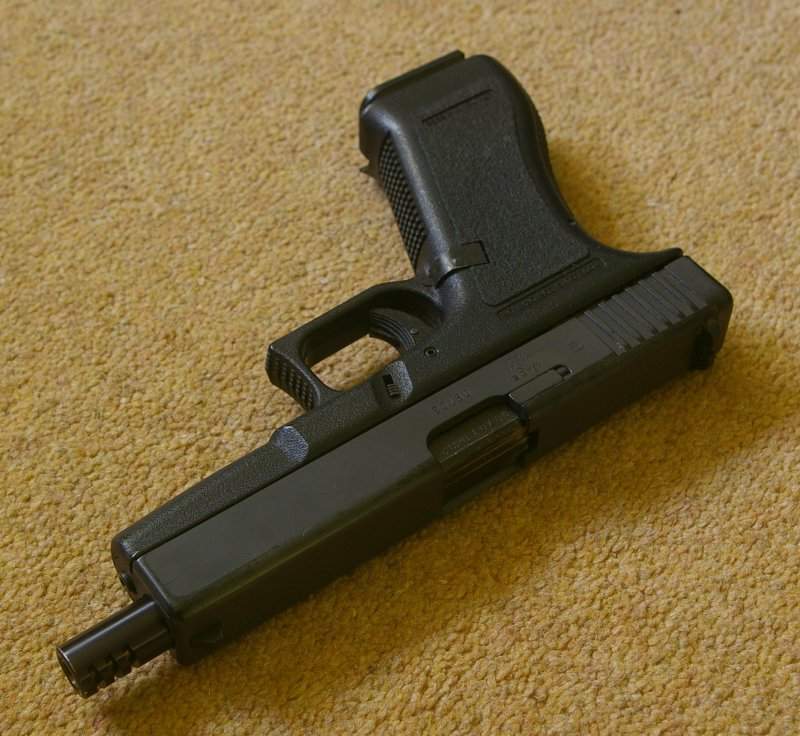
External metal parts are pretty much limited to the outer barrel, selector switch, slide lock, takedown levers and magazine release.
Closer Look
Quality is certainly not lacking in the MGC. Like their H&K P7 it runs deeper than the surface, good though that is.
There is a metal magazine release (the plastic ones on KSC Glocks tend to wear out, causing problems with gas seals between the magazine and blowback unit) and there is a metal recoil spring rod, too, although these parts are plastic on real Glocks.

The inner barrel is brass and extends all the way to the end of the all metal outer barrel, which features those trademark barrel vents.
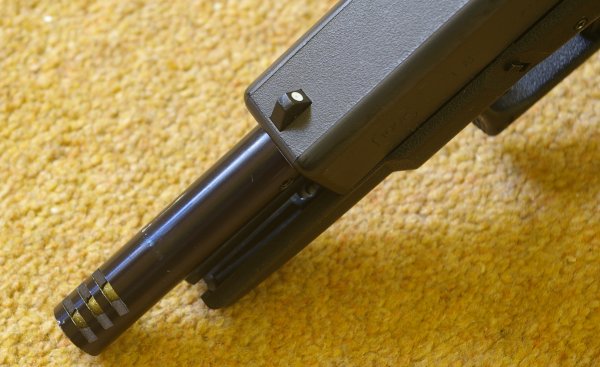
The MGC Glocks are said to be the most realistically marked airsoft Glocks, but they look little different to the older KSC ones I have seen.
On the left side of the slide there is the Glock logo, with 18 AUSTRIA and 9x19 moving back from the muzzle. The left side grip, also feature the Glock logo.
The grip is unusual for Airsoft Glocks too in that it features no finger grooves on the front edge, as all other GBB Glocks I've seen do. This reflects the earlier design of the Glock 18.

On the right side of the slide, there is a small Glock logo behind and below the extractor, a (very non-Glock) "MADE/IN/JAPAN/ASGK" right under the extractor and a serial number under the extraction port. The chamber is marked with this same serial number 9x19 and a tiny Glock logo. The serial number is repeated again on a small plate on the underside of the frame, ahead of the trigger guard. There is a "MODELGUNS CORPORATION" script above the right grip and, at the bottom, "JPN Pat. HI-16959".
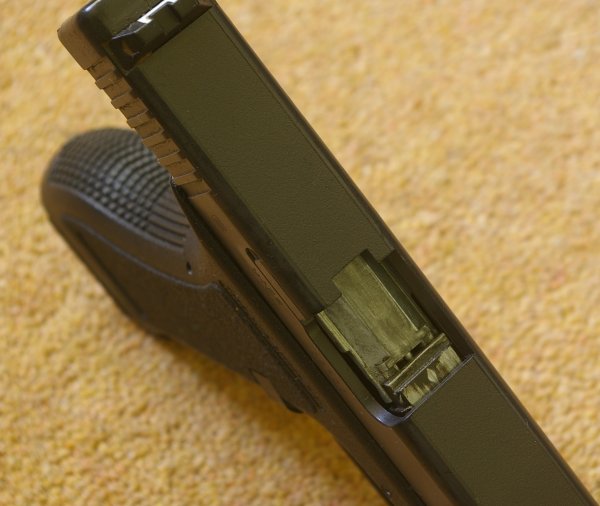
The old style blowback unit (more on that later) precludes an open ejection port, sadly, but the finish on the slide and frame is very good, with the slide top featuring an 'anti-glare' finish, which looks and feels very realistic.
The slide lacks a rail, which will disappoint some, but is correct for this early model Glock. To some, of course, this marks these guns out as all the more desirable for their unique appearance.

At the rear of the gun is the familiar selector device, which is pushed up for semi-auto and down for full-auto. The one on this example is loose, but I suspect that is simply down to natural wear and tear from years of use.
The trademark Glock two-part trigger is also present, but, on this example, the central third of the trigger does not have to be depressed to fire the gun. Other reviews suggest that it was functional on MGC’s Glock 19, so it is likely that this one is just worn out.

The sights will be familiar to anyone who has seen any Glock, real or airsoft. The front one is a small post with a large white dot. The rear is a squared notch outlined by white paint. The rear sight can be drifted left and right in its dovetail, but the foresight is fixed. They are easy to use and accurate enough.
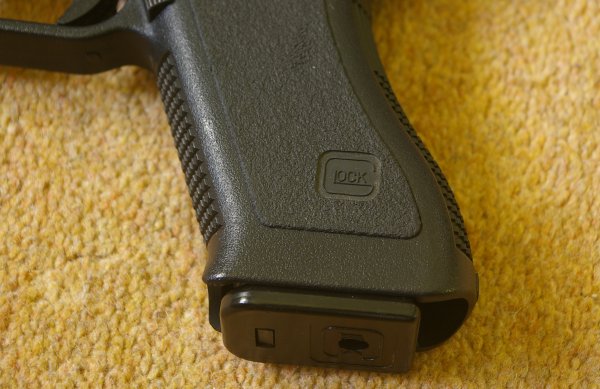
The magazines are unusual for anyone used to modern GBBs. They are plastic shells, with a Glock logo-ed base plate. Inside there is a separate gas reservoir, meaning that there is no need for an O-ring between base and magazine wall, which often dries out, causing leaking magazines; despite their advanced age, both these magazines were totally gas tight.
As with the KSC Glocks, grip length and extended magazines are available (and one of each are shown here). The short magazine holds 15 BBs and the longer one 46, less than their KSC equivalents, but not uselessly limited.
Operation
I don't usually bother describing the operation of a GBB, because they mainly work in the same way, but the MGC Glock's old style system is quite different to most GBBs I have encountered.
Firstly, the blowback mechanism is not in the slide, but attached to the frame and a piston is used to push the free floating slide back, with the usual recoil spring used to pull it back into battery.
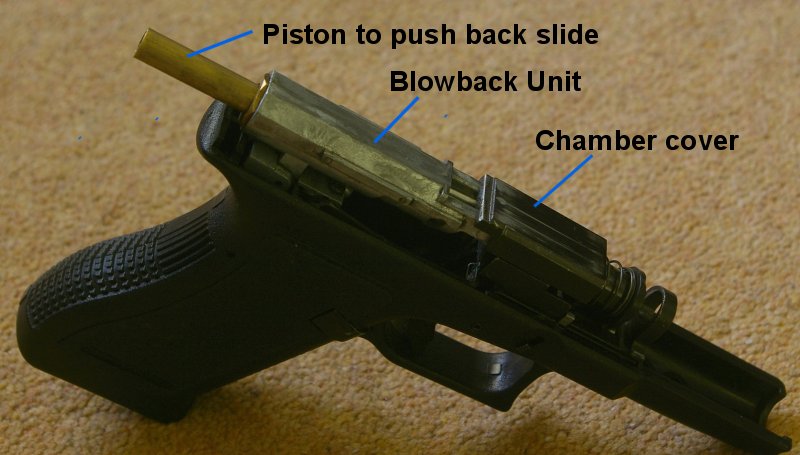
'Blake' on Classicairsoft.com provided the following diagrams which show how the system works.
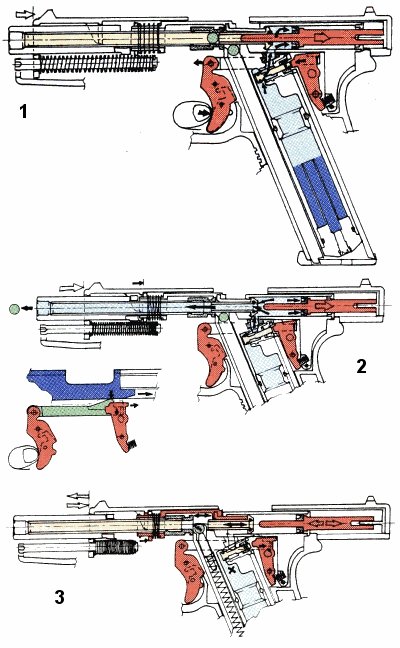
At step 1, the trigger is pulled releasing gas from the magazine. This (instead of firing of the BB), starts to move the blowback piston backwards, taking the slide with it.
At step 2, the forward part of the piston (in the blowback chamber) clears to barrel and allows the same gas to flow forward to fire the BB from the gun. At about the same time, the slide trips the trigger mechanism to close the gas valve.
At step 3, the compressed recoil spring starts to rebound, closing the slide.
This system, especially with the light slide, does not produce much felt-recoil, but does provide for very efficient use of gas.
Shooting Impressions
Past experience with 'classic' GBBs has not been terribly impressive in this respect.
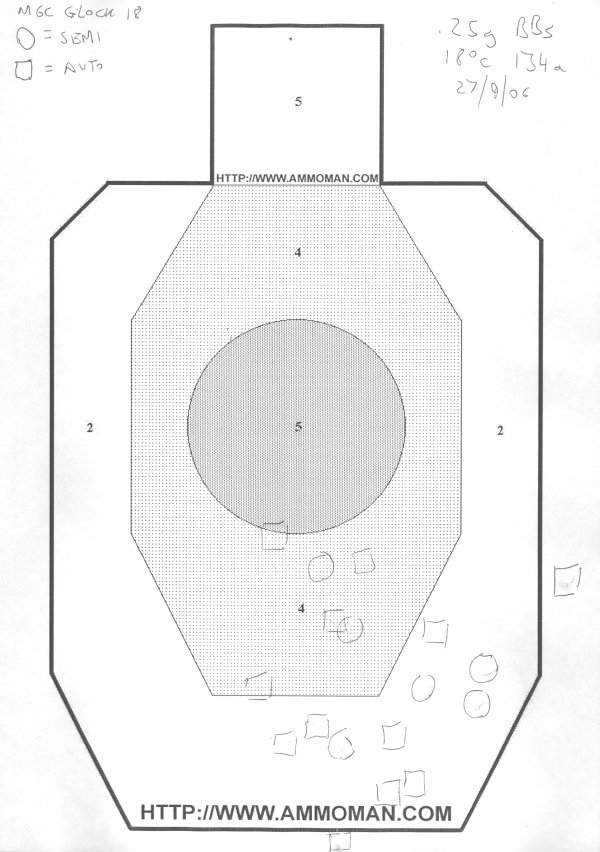
Click on image for bigger version in separate window.
Carrying out my standard 5m/6 round, off hand test, BBs fell reasonably in line with the aim point and in a usably, if far from remarkably, close cluster, but they all fell 1-3 inches low of the aim point, at the centre of the target.
In semi-automatic mode (shown as circles on the target above), the best 5 of 6 BBs fell in a 55mm diameter.
Firing in full-automatic (the squares on the target), the pattern was very similar (best 5 of 6 falling to 45mm), but again low of the target.
Over 10 shots, the old MGC Glock 18 averaged just 167 fps (using 134a gas and I wouldn't risk anything stronger) indoors (at 23C).
| Shot | FPS |
| 1 | 167.7 |
| 2 | 165.2 |
| 3 | 164.4 |
| 4 | 161.8 |
| 5 | 163.7 |
| 6 | 162.6 |
| 7 | 173.4 |
| 8 | 176.4 |
| 9 | 167.1 |
| 10 | 171.4 |
I thought the accuracy may be better with lighter BBs (say .2g ones), so I loaded 30 rounds into the long magazine and returned to my range. It was quite cold (only 16C), but I stuck with 134a gas (for fear of damaging this quite old gun).
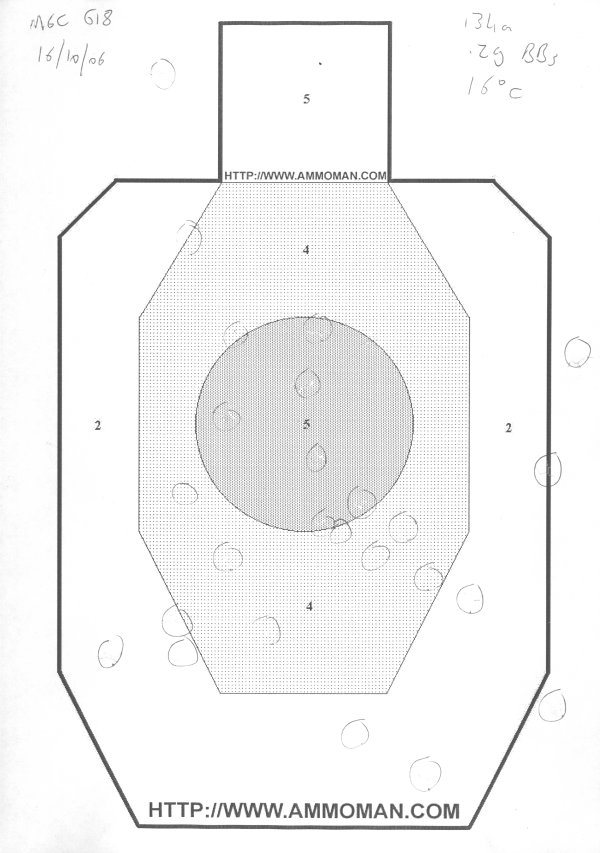
Click on image for bigger version in separate window.
As you can see from this (a mixture of semi and full auto firing, not always of my choice), the .2g BBs fell much more on target (around the centre), but at this temperature and with 134a gas, this was pretty much the effective limit of the range of the gun.
So, it's decently accurate with .2g BBs, but this old design clearly lacks field-skirmishing range, not unsurprisingly, given the lowish power and lack of hop-up.
Trigger pull was 1,170g (41 Oz), which is a medium-heavy weight pull for a GBB, although the gun's odd mechanism means I had to fit a gassed up magazine to test the pull.
Where the MGC Glock 18 does excel is in Rate Of Fire.

The image above (taken for Audacity) shows 12 shots in under half a second. Giving a Rate Of Fire (even on 134a gas) of 1,440 Rounds Per Minute!
Click here to hear the MGC Glock 18 in action.
No other select fire airsoft gun has come close, AEG, AEP or Gas powered and only some of this can be put down to the lightweight slide - Clearly this old gas system provides something modern systems cannot match.
Take Down
Take down is slightly unusual.
The usual takedown catches over the trigger play a part, but you need to pull the outer and inner barrel out through the front of the slide (leaving the breech in the slide) with them pushed down.

The slide can then be pushed back and lifted up off of the frame.
Conclusions
Overall, like all MGC guns from the past, this is a collector's piece, rather than a usable skirmish sidearm.
The look of the gun (even on this battered version) is quite good and realistic, but it feels very light and I would not want to risk running high power gasses through it.
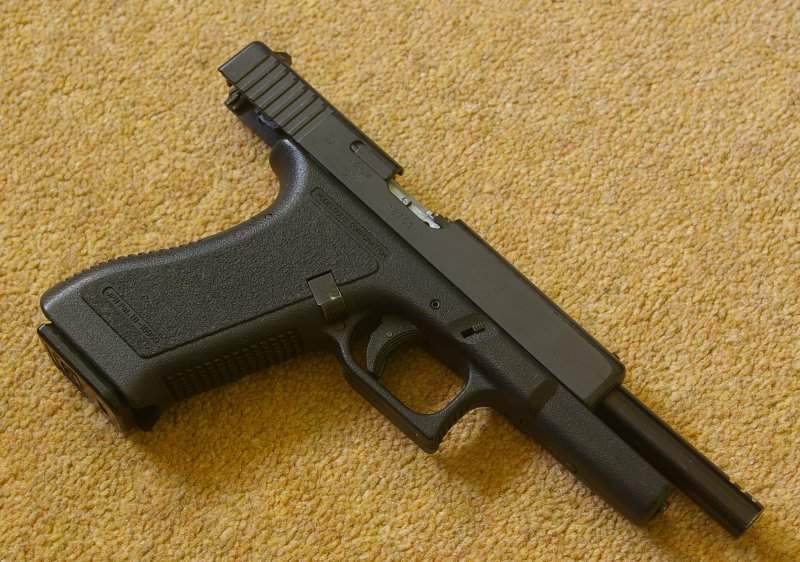
The markings are more realistic than a KSC/KWA Glock 18C and the long, vented barrel make it a distinctive looking Glock (an expression I never expected to be able to type).
For a collector, the MGC Glock 18's an interesting addition (especially for a Glock fan), but no-one should search one out if they plan to skirmish with a GBB Glock 18.
Just buy the KSC one for that.
Weight : 570g with 160g short magazine (210g extended magazine)
Realism : ***
Quality : ***
Power : **
Accuracy : ***
Back to the Homepage